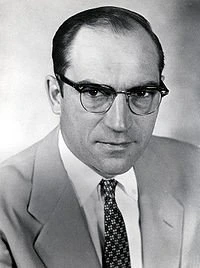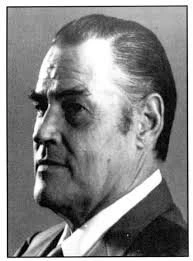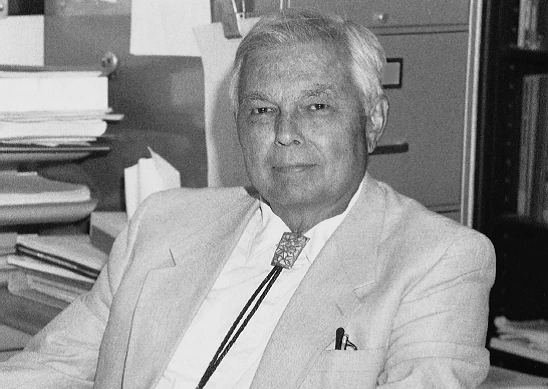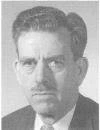Sometime in the late 1950s to very early 60s, two University of Arizona faculty, John W. Harshbarger and T.L. Smiley, sat in a bar at the Denver airport with colleagues from the U.S. Geological Survey. As told by Eugene Simpson in Volume 1, No. 1 of the Department of Hydrology Alumni Newsletter (April 1986):
"It was at that bar that Professors John W. Harshbarger (Big John as he was affectionately referred to by his students), then chairman of the Geology Department, and T.L. Smiley, then director of the Laboratory of Geochronology, sat with several colleagues from the U.S. Geological Survey, waiting for a plane. The USGS colleagues included, among others, Luna Leopold, then Chief Hydrologist of the Water Resources Division, and Walter Langbein and Nick Matalas, research hydrologists. History does not record what they drank nor where they were going, but we do know what they discussed (here freely paraphrased). 'This country needs,' said one of the Survey men, 'a university program in hydrology that will teach ground water and surface water as an integrated discipline, and the University of Arizona is the place to do it.' 'I agree,' John replied, 'but we'll need the cooperation of the Survey.' 'You got it,' said Luna. Then and there a tentative program was outlined--probably on the back of an envelope taken from one of John's pockets."
As the nation's population increased through the first half of the 20th century, so did demands for water resources. Improved knowledge about the amount and distribution of water and, particularly, the advancement of the science of water--hydrology--became increasingly important. Through this period, much of the development of hydrologic knowledge occurred through the research and publications of the Water Resources Division of the U.S. Geological Survey (USGS-WRD). No formal academic program existed at the time, so the scientists in USGS-WRD were largely trained "on the job" from expertise in related disciplines.
Luna Leopold, one of the most influential hydrologists of the 20th Century and USGS-WRD’s Chief Hydrologist from 1956 to 1966, recognized the need for the establishment of formal academic training in the discipline of hydrology. One of Leopold’s goals was recognition of USGS-WRD as the premier national and international scientific water-resources organization, and achieving that goal relied on increasing the skills of current staff and hiring new employees specifically trained in hydrological sciences. Given the absence of university programs to provide this training, establishment of both short courses and degree programs were critical.
Under Leopold’s leadership, many universities were encouraged to develop academic programs to increase the numbers of specifically-trained hydrologists graduating with bachelors and graduate degrees. Among these institutions were Iowa State University, Colorado State University, Georgia Institute of Technology, the Universities of Arizona, California, Michigan, Illinois, Wisconsin, and New Mexico, as well as the California Institute of Technology, Johns Hopkins University, Harvard University, and Stanford University.
The USGS-WRD pursued contracts with many institutions in pursuit of establishment of hydrology degrees, but specifically selected the University of Arizona as the focus of its efforts. Three people in Tucson at the time were particularly influential in drawing the focus to Arizona: John W. Harshbarger, Eugene S. Simpson, and Thomas Maddock Jr. All three were either actively employed by or were previously employed by the USGS-WRD in Tucson. All three were well connected in the USGS and well respected.
The rich history of John W. Harshbarger is written in detail in other places, but in brief, Harshbarger earned his MS and Ph.D. from the University of Arizona in 1948 and 1949 respectively, worked briefly as an Assistant Professor of Geology at the University, and then served as the District Geologist of the USGS-WRD Groundwater Branch in Tucson until 1959. During this time, Harshbarger developed in the USGS skills that were essential in developing the early staffing and curriculum in HWR. Harshbarger then became a Professor of Groundwater Geology at the University, Department Head of Geology, and finally chairman of Hydrology and Water Resources in 1966.
Eugene S. Simpson was first employed at USGS-WRD in 1945 to investigate groundwater resources in the northeastern U.S., but was quickly recruited by C.V. Theis to work with a new USGS team on hydrogeologic questions related to nuclear facilities. Simpson worked at the USGS until 1962 and then joined HWR.
Thomas Maddock Jr., father of Thomas Maddock III, enjoyed a close relationship with Luna Leopold that spanned much of the careers of both men. From 1930 to 1942, Maddock supervised Leopold when both worked at the Soil Conservation Service. Later, in 1957, Maddock was recruited into USGS-WRD as a staff scientist from the Bureau of Reclamation, likely at the request of Leopold, who was then the Chief Hydrologist of USGS-WRD. In 1961 Leopold asked Maddock to serve as the Branch Chief of Surface Water, and in 1962 Maddock asked for reassignment to Tucson as a Research Hydrologist.
The initiation of HWR was a joint effort of the University and USGS-WRD, and, in the early years from around 1961 to 1966, USGS assigned several of its most respected hydrologists to help develop curriculum, instruct classes, and advise students. Those employees included Herb Skibitzke, John Ferris, Nick Matalas, Jose de Costa, and Thomas Maddock Jr. Luna Leopold himself was directly engaged in reviewing course curriculum as recorded in letters between letters between Leopold and Harshbarger.
Through time, HWR developed its own dedicated faculty and the USGS role in providing staff time and expertise tapered off. The vision of John Harshbarger, Luna Leopold, Eugene Simpson, Thomas Maddock, Jr., Walter Langbein, and others has, however, been fully realized. To this day, the USGS Arizona Water Science Center maintains close ties with HWR, and relies on the excellent graduates of the Department to execute its programs and, ultimately, to serve as permanent employees in Arizona and across the nation.






